Bill Simons
It would have been a great bounty if, in our era, only Roger Federer had been on stage. But for the game to have also had Rafa is just a miracle.
“Why not?” I joke to myself, “The Italian Renaissance had both Michelangelo and Leonardo da Vinci.” Even more astounding is that we’ve also been blessed with Novak Djokovic, who combines breathless technique, lightning speed, a flexibility that probably impresses a yogi or two and a fierce will only the greatest of stars can grasp.
Assorted geniuses in the late 19th and early 20th centuries set the table for modern life. But all of them – say Englishmen Charles Darwin and Charles Dickens, American Thomas Edison, German Karl Marx, Austrian Sigmund Freud, Spaniard Pablo Picasso and a patent clerk in Switzerland named Albert Einstein – excelled in many different times and places.
In the modest history of men’s tennis, one storyline stands above all others, a unique sporting confluence: the nearly simultaneous emergence of three dazzling European stars born within six years and 1,400 miles of each other who were destined to light up the tennis heavens with a gleaming brilliance for the ages. Who could have imagined such a scintillating synergy? To me, it’s almost as if Bach, Mozart and Beethoven all amazed us at the same time.
For about 15 years, before our eyes, the three best players in tennis history have battled each other while lifting the sport to stratospheric heights and winning 53 of the last 62 Slams. Yes, there were many fabulous players before the Big Three: Tilden, Budge, Kramer, Gonzales, Hoad, Emerson, Laver, Borg, Connors, McEnroe, Sampras and Agassi were wonders. But Roger, Rafa and Nole are a force like no other.
New Yorkers of a certain age recall a golden era of just seven summers when three baseball icons – Willie Mays, Mickey Mantle and Duke Snider – roamed New York centerfields and drew comparisons. Arnold Palmer, Jack Nicklaus and Gary Player laid the foundation for modern golf. Magic Johnson and Larry Bird rescued the NBA. But no other troika has ever transformed and lifted a sport quite like tennis’ Big Three. “They’ve basically left realism in the rearview mirror,” noted Shane Ryan. And, although Federer is in his twilight, a clear end is still not in sight.
So, can we say who is the greatest among them? Let the debate begin. Or maybe not. Some insist it’s a fool’s errand. Why bother determining the greatest? But there are few things more human than to judge and rank. Of late, many fans have been drawn into the GOAT discussion. Each player has his avid backers. It touches the imagination, an is the most intriguing question tennis has.
Yet until fairly recently the GOAT issue stirred only a few ripples. Unless you were the vice president of the Jack Kramer fan club, there wasn’t much question that Philly’s fine Bill Tilden was the best player of the first half of the 20th Century. Then many noted Rod Laver’s fabulous feat of twice winning all four Slams in a calendar year. Soon the Aussie was said to be the best. But he didn’t dominate. The banished pro spent many a season toiling in obscurity and then was celebrated more for his quiet humility than his charisma.
As the Open era transformed tennis, there was much focus on Bjorn Borg, who sprinted to six French Open and five straight Wimbledon titles. Graceful and charismatic, he drew adulation as he battled a couple of bad-boy southpaws, McEnroe and Connors. But then he quit at 26. Next, Boris Becker and Stefan Edberg had moments of glory, just before the outbreak of the SamprasAgassi wars. In 2002, when Pete beat Andre to win a record 14th Slam, he solidified his position as the GOAT.
But it was hardly a big deal. Enter kid Federer: smooth, unafraid, fast as the wind and blessed with every shot in the book. He loved the game, he loved to win and he lit up the big stages of tennis. And tennis loved it when, in 2001, at the All England Club, the little known longhaired wannabe downed Sampras (who’d won four straight Wimbledons). In the only time they met, Roger seemed to pound a statement onto tennis’ cathedral door. The maestro’s majestic symphony soon sounded. Tennis, and maybe all of sports, had never seen such a feel-good display of athleticism, quick-flick spontaneity, consistency, dominance, balance, flow and sheer beauty.
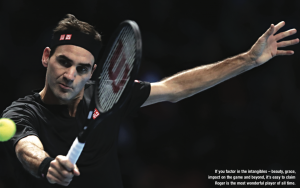
“He’s been touched by the gods,” noted Neil Harman. “Everything about it is effortless. Everything about it is beautiful on the eye.” It was as if Roger were skiing down an alpine mountain with a confident yet controlled abandon. From 2004 to 2009, he won 15 of 25 Slams. [Flash comparison: early in his career Tiger Woods won 6 of 9 majors. At his peak, Roger won 6 of 8.]
Yet, in 2007 the London Times said Roger was washed up. A year later Djokovic’s mom contended, “The king is dead.”
Wrong. Longevity is one of Roger’s greatest gifts. He would go on to be No. 1 for a total of 310 weeks. With his 103 tournament wins, he is only six behind Jimmy Connors. From 2005 to 2012, Federer reached the quarterfinals of every Slam. At majors, the term “bad loss” wasn’t in his vocabulary. Yes, before Nadal’s emergence in 2005, the field, led by Safin, Hewitt and Roddick, was modest. In 2004, 2006 and 2007, Federer won three Slams and he collected both the US Open and Wimbledon four years in a row. Incredibly, he reached 23 straight Slam semis.
Recently Stefanos Tsitsipas told IT, “Roger makes you feel like you’re really bad at tennis. He walks around, he flicks his head, and I don’t even know what I’m doing out here.”
Roger’s signature moment came in 2009. As Sampras looked on at Wimbledon, he broke the American’s record and won his 15th Slam. After his triumph, in a master stroke of branding and self-congratulation, he donned a stylish cream blazer with the number 15 emblazoned on it. The message was clear: “Before you is royalty.” His crown glowed. All bowed to honor the monarch. Here was the best of all time – discussion over. For years it was understood: Roger was the GOAT.
Modest Rafa periodically would score a huge win, but then assure us, “No, no, no, I’m not No. 1. It’s Roger – he’s amazing. He’s the best in all of the history – no?” Yes, but a funny thing happened on the way to the coronation. Nadal kept on beating Roger – and not only on clay (where he’s up 14-2). He prevailed at the best match of all time, the 2008 Wimbledon “Strokes of Genius” final, and he beat Roger with some regularity on other surfaces – winning 10 of their 24 matches on hardcourts and grass. Overall, Rafa has a decisive 24-16 head-to-head advantage over Roger. Federer defenders note that Roger could still be the third best clay court player of our era. And Ted Robinson quipped, “There are those that like to continually diminish Roger by pointing out that he can’t beat Rafa on clay, which is true. But who has?” Still, Pat Cash asked a frequently heard question: “How can Roger be the best in history when he’s not the best in his era? Sampras was blunt, proclaiming, “You have to beat your rival.”
Federer is 16-1 in Slam finals against players other than Rafa and Novak, but is 4- 10 against Nole and Nadal. Andre Agassi said, “I’d put Nadal No. 1 and Federer No. 2…Roger separated himself from the field for four years. He separated himself from Roddick and Hewitt. Nadal had to deal with Federer, Djokovic, and Murray in the golden age. He has done what he has done – and he’s not done yet.”
Italian Jannik Sinner recently claimed, “There are no words to explain Rafa. He’s very superior mentally. He hits very hard like the others, but understands moments like no one else. He knows exactly what to do, and how and when to do it.” The king of clay is the 13-time French Open champ. He’s only lost twice at Roland Garros, he’s prevailed at 60 clay tourneys, he’s won 81 straight clay matches and has a 92% winning record on dirt, while Roger has won 87% of his grass court matches. No one has been so dominant on a single surface as the Spaniard. He won at the ATP 500 level (11 Barcelona Open titles), Masters 1000 (11 Monte Carlo titles) and Slams (13 French Open titles).
Plus, of course, Nadal is tied with Roger for the most Slams. And he’s virtually tied with Djokovic, having the highest career winning percentage of any player in the Open Era. He’s led Spain to five Davis Cup titles, he’s won three Masters doubles titles, and only he and Agassi have claimed a career Golden Slam: winning every major and anOlympic singles gold medal.
Many say that Rafa – even more than Connors and Hewitt – is the greatest battler of all time. Who brings more heart to a tennis match? His forehand is a unique weapon that he uses to punish Federer (and plenty of others). Almost unstoppable on clay, he has adeptly transferred his talents to hard and grass courts, winning four US Opens, two Wimbledons, and one Australian Open. And what other ATP star this side of Juan Martin del Potro and Kei Nishikori has suffered more hobbling injuries than Rafa, who’s missed ten Slams and scores of other big tourneys due to injuries or the pandemic?
Andy Murray told IT, “If Rafa and Roger met at the peak of their careers on a neutral surface…Rafa would win because he’s beaten Roger maybe double the times that Roger’s beaten him. The one court where I favor Roger a lot is indoors…But on all the other surfaces, I give Rafa a slight edge. He has a good game to play against Roger…Rafa is so solid throughout the match he doesn’t give him many errors and Roger hasn’t returned Rafa’s serve as well as you might expect.”
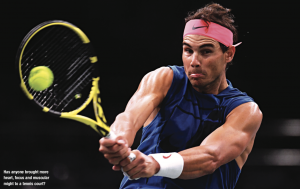
But not so fast, you Rafa-ites! What about Nole? He’s far less muscular than Nadal. His game isn’t as pretty as Federer’s. But it’s not hard to claim his stats are better than either. Yes, he blew an opportunity in New York and “only” has 18 Slams. Still, he has a winning record against both his key rivals (27-23 vs. Roger; 29-27 vs. Rafa) and he just beat Roger’s record of most weeks at No. 1 – 310.
Last year Nole tied Sampras’ mark for most years finishing as No. 1: six. He has, by far, more Masters (36) than anyone. He’s the only player to win all nine of them and – get this – he’s actually won each of them twice – amazing! He’s more versatile than his rivals. A threat on any surface, he’s beaten Nadal in every Slam. His 2015 season, when he won three Slams and went 82-6 at a time when his foes were at their peaks, is said to be the most impressive season of the Open era.
Dave Arkow of the Harvard Sports Analytics Collective noted that in Big 3 match- ups, “Djokovic has the highest winning percentage on both hard (62%) and grass (63%) while, as expected, Nadal leads on clay (78%). Interestingly, Nadal is well behind both Djokovic and Federer on hard (34%) and grass (38%).”
Djokovic, 33, is about a year younger than Nadal and almost six years younger than Federer. Arkow observes that Novak “started out slowly and trailed his two rivals in the beginning…but picked up his pace and by age 32 had won 18 Slams – the same number Federer and Nadal had at that age. In contrast to Novak’s late bloom, Federer was stuck at 17 from age 30 to 34, which proves that he peaked the earliest and now is well into his decline. It doesn’t seem likely that he’ll win another Slam…If Djokovic is able to maintain his trajectory, he looks likely to pass Federer fairly soon. Meanwhile, even though Djokovic and Nadal are on similar trends, Rafa is reliant on clay.
“Novak’s peak age of 29 was also the latest (likely because he was competing against a prime Federer and prime Nadal), whereas Nadal peaked at 27 and Federer at 25, which is a good sign that Novak will continue to be a stronger contender at each Slam for many years.”
Health is a key factor and Novak has suffered fewer long-lasting injuries than his rivals. Plus, Arkow notes, “The fifth set is a good measure of a player’s physical and mental endurance, and Djokovic has a greater all-time fifth-set winning percentage (76%) than Federer (57%) and Nadal (67%).”
While Federer still has his chances to win Slams, particularly at Wimbledon, and Nadal may well keep on winning the French Open until he’s eligible for AARP, Djokovic is still near his peak. His fitness is a key asset. His intent is fierce. He clearly would like to wear the GOAT crown. He might play into his 40s, and he could win five or six Slams – maybe more. He’s won six of the last ten majors.
Rafa’s uncle, Toni Nadal, recently observed, “At the moment Federer is the best…[But] we have a way to beat him…I know what we have to do. But when we play Djokovic, many times we don’t know exactly what we have to do. This is more difficult. I prefer to play against Federer.” The pro-Djokovic stats seem endless: he held all four Slams at the same time and he won 43 matches in a row.
Still, in the GOAT race, Roger has certain advantages. Long ago he was anointed as the greatest. It’s hard to dethrone a king. Plus, a key question in the GOAT debate is how much intangibles count. Muhammad Ali is widely considered to be the boxing GOAT. But he doesn’t have the best boxing record ever. Ultimately the GOAT discussion comes down to a left brain/right brain divide. Drag- net’s Joe Friday, the long-ago TV detective, would always insist, “Just the facts ma’am, just the facts.” In contrast, Serbian Janko Tipsarevic’s Dostoevsky tattoo tells us, “Beauty will save the world.”
Jon Wertheim implied that in the GOAT race there might be a metric for artistic impression. “Some of it is what you see with your naked eye. You just see Federer do things with a tennis ball that can’t be ex- pressed. There’s no statistic that says any- thing about picking a ball up and short-hopping it with a one-handed back- hand and flicking it cross-court. I just watch Federer and can’t escape the fact that I don’t think anyone has played the sport better.”
Historian Richard Evans challenges us: “Define best. It’s not just about winning titles or beating rivals. It’s also about how you play the game. With enormous respect to his rivals, Roger just plays tennis better than any- one I have ever seen – including Lew Hoad.”
Agassi said, “Federer was a guy who came in and just really took the game light years ahead.” Jim Courier added, “He’s the most complete player I’ve ever seen. He has every single shot in the book…He does things with grace. He does it with class. He does it with incredible efficiency. It would be hard to imagine this game finding someone better than him going forward.”
There was nothing like the triumphant supremacy of Federer in his prime. Here was the power of Beethoven, the delicacy of Mozart, the street-fighting grit of Mick Jagger – not to mention a GQ-worthy urban chic. He inspired so many to watch or play and was the star so many had hoped to see. People traveled thousands of miles just to watch him practice. If you strictly go by the metrics, Roger probably isn’t your GOAT. But if you factor in the intangibles – beauty, grace, impact on the game and beyond, Roger is the most wonderful player of all time.
Still, Rafa has that head-to-head record over him and, by the next French Open, should claim the most coveted stat in the game – most Slams ever. And, if Nadal does what he has done for the past four years and wins at least a Slam a year, he could claim the GOAT crown.
As for Djokovic, he’s not the prettiest, the most appealing or the most popular. But what a package he delivers: speed, technique, fit- ness, flexibility, clutch play, smarts and fierce desire. Tipsarevic told IT that Nole’s greatness was not because he came from poverty, but because “he wants to be the best of all time and nothing else, and is willing to do whatever it takes…Nothing else satisfies his hunger. You saw this with LeBron, Kobe, Ronaldo and Muhammed Ali.” And ultimately, the statistics don’t lie. Never mind that he’s won more prize money than anyone. Novak’s head-to-head records, weeks and years as No. 1, his Masters play, his consistency, his versatility on different surfaces, his peak performances and clutch play stand out. His numbers tell the story.
Going by the metrics, by a narrow margin, Novak is the greatest of all time. And the man with the short hair and the long resume, who’s still near his peak and a threat at every Slam, could climb much higher.
We’ll see.




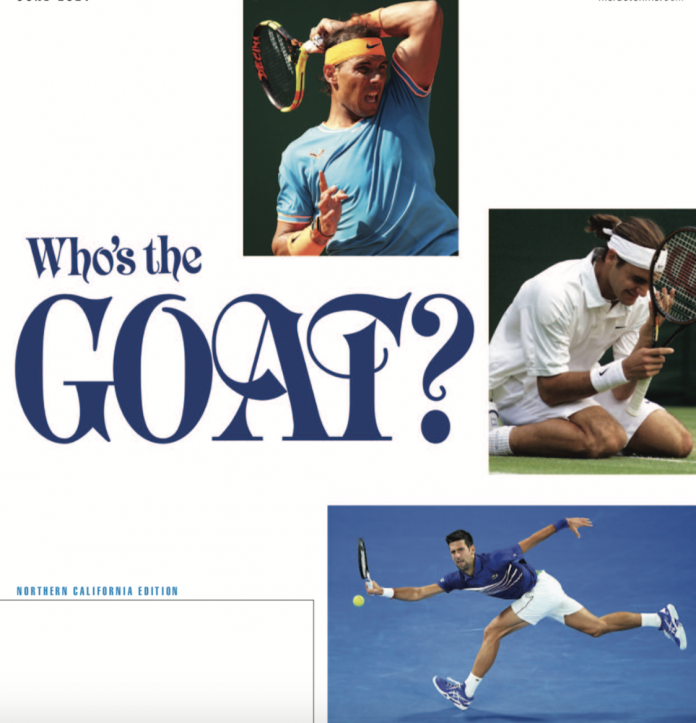
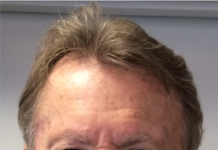

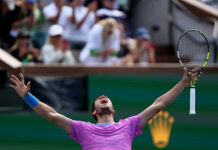














Best analysis I’ve seen. Really enjoyed the read.
Thanks so much. Appreciate. Where do you live?